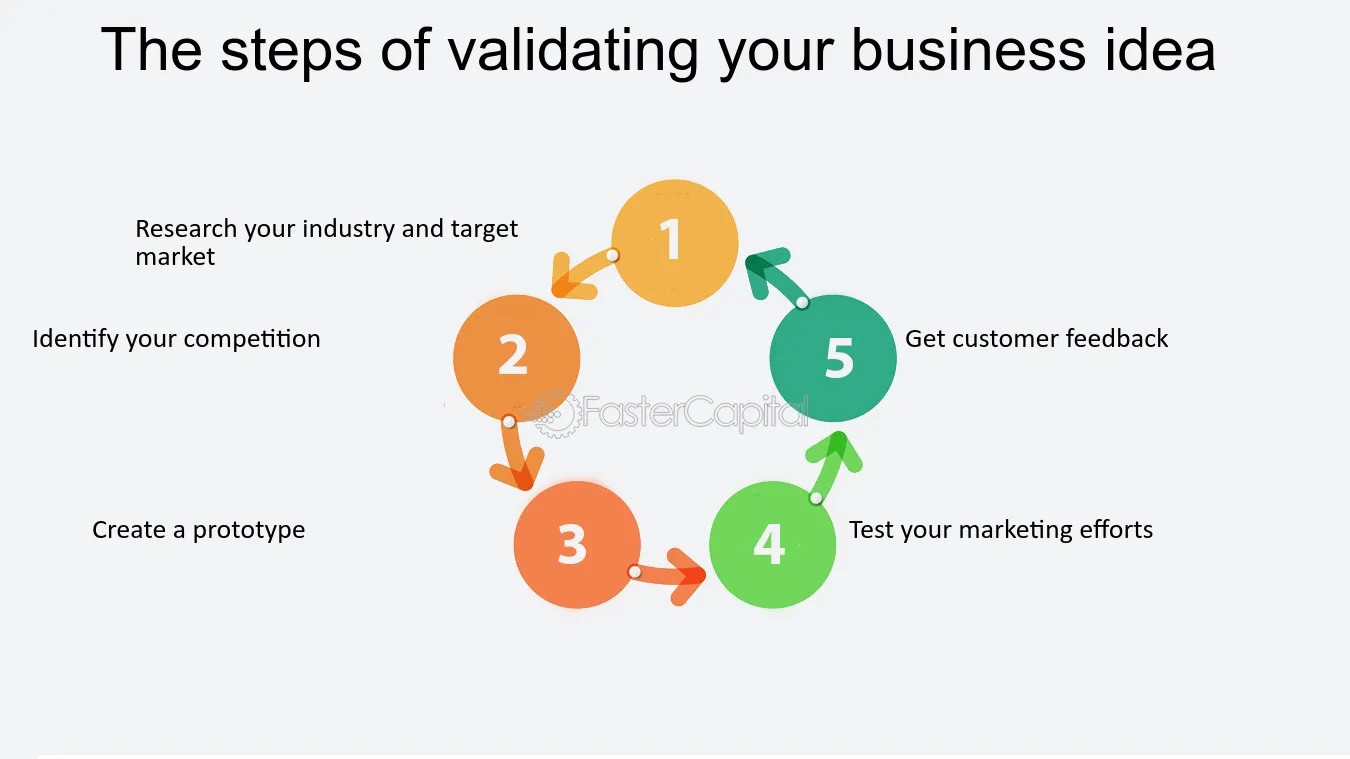Are you worried about finding your startup’s perfect market fit? Fret not! In this guide to validating your startup idea, we’ll walk you through the crucial steps to ensure you’re on the right track.
Validating Your Startup Idea: A Guide to Ensuring Market Fit involves identifying the problem your startup aims to solve, understanding market demand, assessing competition, and testing market size. By following these steps, you’ll be well on your way to achieving success in your new venture.
Don’t miss out on valuable insights to drive your business forward. Keep reading, and gain the confidence and knowledge you need to validate your startup idea effectively!
Identifying the Problem and Understanding Market Demand
The initial step to validate your startup idea is to identify a problem that affects a significant number of people. The importance of problem significance cannot be overstated – it sets the foundation of your business. Consider how many people are experiencing this issue, and delve into their demographics to better understand the market demand.
Recognize and articulate the specific problem your startup aims to solve by gauging its universality and relevance
It is essential to confirm the significance of the problem your startup is aiming to solve. For example, if your idea is focused on solving a specific issue within the healthcare industry, it’s crucial to know how many people are affected by the problem and understand their background. Additionally, understanding the relevance of the problem you are trying to address makes it easier to identify potential customers and market segments.
Conduct open-ended customer conversations to ascertain the depth of the problem and willingness to seek a solution
According to a guide to evaluating startup ideas, entrepreneurs are advised to pay close attention to how potential customers express their issues when discussing it with them[^1^]. This presents an invaluable opportunity to gain insights into the depth of the problem and people’s willingness to invest in a solution.
It is vital to engage in open-ended conversations with your potential customers to understand their pain points better and explore their willingness to pay for a solution. One strategy to achieve this is to interview 25-50 people with the problem at hand and examine their language while describing their experiences[^2^].
Determine potential customers’ readiness to invest in the solution, including budget considerations and alternative solutions they may be utilizing
To validate market fit, it is crucial to assess potential customers’ financial readiness to invest in your solution. Consider their available budgets and the existing alternatives they may be utilizing to address the issue. One way to gather this information is by analyzing market spending statistics on existing solutions, which can offer insight into the financial figures customers are comfortable allocating to solve the problem.

Source: Broscorp
Employ deep market research and analytics for industry trends, customer pain points, and interviews for genuine insights
To gain actionable insights, you should engage in deep market research and analytics. Investigate industry trends, customer pain points, and engage in interviews to develop a complete understanding of the problem and market fit. This process can be incredibly valuable, helping you uncover crucial information about your target audience and providing insights that inform your product or service development strategy[^3^].
For example, when evaluating a healthcare startup idea, it is essential to analyze industry trends, such as the rise of telemedicine and the adoption of digital health platforms. Dive deeper into customer pain points by conducting surveys or interviews with potential users, understanding their challenges and the features they value most. Understanding these demands will allow you to develop a more refined and market-driven solution.
Identifying the Problem and Understanding Market Demand: Summing Up
In summary, validating your startup idea begins with recognizing the problem, understanding the market demand, and engaging potential customers. To ensure your offering aligns with market needs, it is essential to:
- Confirm the problem significance and relevance by considering the number of affected people and their demographics
- Conduct open-ended customer conversations to gauge the problem depth and willingness to invest in a solution
- Assess potential customers’ financial readiness to invest in the solution, and research existing alternative options
- Employ deep market research and analytics to understand industry trends, customer pain points, and gather genuine insights through interviews
By following these steps and continuously refining your understanding of the problem, you will be well-equipped to develop a product or service that resonates with your target market and positions your startup for long-term success.
Comprehensive Competitive Landscape Analysis to Identify Gaps and Opportunities within Existing Market Players
In validating your startup idea, understanding your competition is vital in carving your niche and identifying strategies to succeed in the market. Begin with a detailed investigation of the competitors’ strengths, weaknesses, and customer feedback. This can be achieved through analyzing their product offerings, market presence, and market share.
Look for specific competitive features to understand what differentiates them in the market. Pay special attention to general customer sentiment and feedback to ensure that your product or service addresses pain points that are unmet or poorly met by your competitors.
Leveraging social media, forums, and review platforms will help you gain insights into customers’ opinions and unaddressed needs. Combining this information with market analysis will give you an advantage in shaping your startup’s direction.
Utilize Top-Down and Bottom-Up Approaches for Accurate Market Sizing to Attract Early-Stage VC Investments
According to a guide on ensuring startup success, it is important to “conduct pilot tests or beta launches to a limited audience” and test different pricing models or strategies. This is a solid way to accurately size your market and attract venture capital investments.
A top-down approach to market sizing involves analyzing macroeconomic data, such as industry sales and market share, while a bottom-up approach entails evaluating microeconomic data, such as individual product sales and customer demographics.
By integrating both approaches, you can accurately estimate the total addressable market (TAM) for your startup. This analysis will help you preempt potential threats, identify opportunities, and devise strategic plans to capture the market.
Consider Regulatory Implications Tailored to Your Startup Industry, Ensuring Compliance and Anticipating Legal Evolutions
Navigating the intricate landscape of industry-specific regulations is critical for any business. Understanding the regulatory bodies and standards relevant to your startup is paramount in ensuring compliance and mitigating legal risks.
Be it the Food and Drug Administration (FDA) for health-tech startups, the Federal Trade Commission (FTC) for consumer protection in e-commerce, or the Securities and Exchange Commission (SEC) for fintech startups, staying up-to-date with the changes in rules and guidelines is essential for business survival.
As regulatory environments are constantly evolving, anticipating future changes allows your startup to stay ahead of the curve and create a strong competitive advantage.
Prepare for Strategic Positioning and Innovation to Differentiate in a Competitive Market
The significance of determining product-market fit cannot be overemphasized. As stated in a LinkedIn article, “determining your product-market fit is crucial to ensuring you’re addressing customer pain points and increasing the likelihood of success.” Achieving product-market fit within a competitive market involves consistent innovation and strategic positioning by understanding your unique selling proposition (USP), as well as your target market’s preferences and needs.
To position your startup effectively, take note of the following:
- Identify the key differentiators that set your product apart from the competition.
- Clearly articulate the value proposition and consistently communicate it to your target audience.
- Continuously work on refining and improving your product or service offering, adapting to shifts in customer demand and industry trends.
Frequently Asked Questions
How can I gather information about my competitors?
Information about your competitors can be found across multiple channels such as their websites, social media profiles, industry reports, news articles, and customer reviews. Thoroughly analyzing these sources will give you insights into their strengths, weaknesses, and customer sentiment about their offerings.
What are top-down and bottom-up approaches in market sizing?
Top-down market sizing starts with macroeconomic data, such as industry sales and market share, to estimate the total addressable market (TAM) for your product. On the other hand, a bottom-up approach focuses on microeconomic data, such as individual product sales and customer demographics, to derive the TAM. Combining both methods provides a more accurate estimate of your startup’s potential market size.
How can I stay updated on industry-specific regulations?
One way is to subscribe to newsletters from relevant regulatory agencies, which often provide updates and announcements on industry regulations. Additionally, consider joining industry associations or expert forums, which can provide further guidance and insights regarding regulatory changes and the industry landscape.
In a digital age, do I still need to conduct beta tests?
Absolutely. Beta testing remains a critical step in validating your product. It is an opportunity to gather valuable feedback from real users that can help identify issues or areas of improvement. Online or digital platforms provide an additional channel for you to conduct beta tests with a potentially wider audience.
What are some key elements of strategic positioning in a competitive market?
Some key elements of strategic positioning include identifying your unique selling proposition (USP), understanding your target market preferences, clearly articulating and communicating your value proposition, and continuously refining your product or service offerings to adapt to shifts in customer demand and industry trends.






